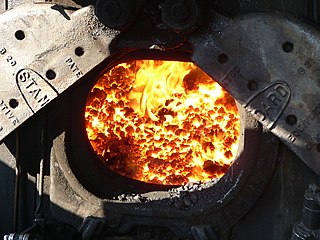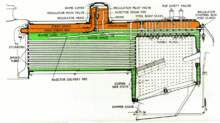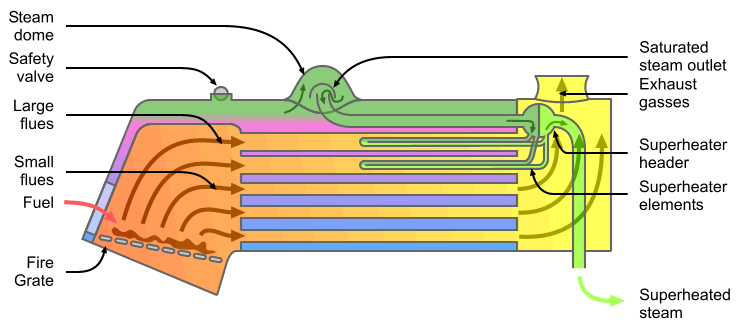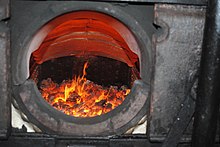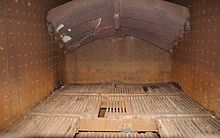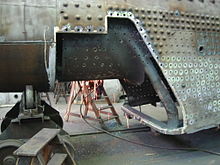86:
of the firebox to hold the fire. An ashpan, mounted underneath the firebox and below the grates, catches and collects hot embers, ashes, and other solid combustion waste as it falls through the grates. In a coal-burning locomotive, the grates may be shaken to clean dead ash from the bottom of the fire. They are shaken either manually or (in larger locomotives) by a powered grate shaker. Wood-burning locomotives have fixed grates that cannot be shaken. Wood ash is generally powder which will fall through the grates with no more agitation required than the vibrations of the locomotive rolling down the track. The fire grates must be replaced periodically due to the extreme heat they must endure. Combustion air (primary air) enters through the bottom of the firebox and airflow is usually controlled by damper doors above the ash collection pocket of the ash pan. A locomotive that burns liquid fuel - usually "Bunker C" fuel oil or similar heavy oil - does not have grates. Instead, they have a heavy metal gauge firing pan bolted tight against the bottom of the firebox. The firing pan is covered with firebrick and the firebox has a firebrick lining, usually up to the level of the firebox door, all the way around the firebox. The oil burner is a nozzle containing a slot for the oil to flow out onto a steam jet which atomizes the oil into a fine mist which ignites in the firebox. The oil burner nozzle is usually mounted in the front of the firebox, protected by a hood of firebrick, and aimed at the firebrick wall below the firebox door. Dampers control air flow to the oil fire.
131:) attached to the front wall (boiler throat plate) of the firebox immediately beneath the firetubes. This extends backwards over the front third to half of the firebed. It is supported on arch tubes, thermic syphons, or circulators. The brick arch directs heat, flames, and smoke back over the fire towards the rear of the firebox. Visible smoke contains unburned combustible carbon particles and combustible gasses. The purpose of this redirection is to cause more complete combustion of these particles and gasses which make the locomotive more efficient and causes less visible smoke to be emitted from the stack. Without the arch, flames and visible smoke would be sucked straight into the firetubes without having been fully burned, causing visible smoke to be emitted at the stack. The invention of the brick arch allowed locomotives to burn cheaper coal (which contains volatiles) instead of coke, it having been a legal requirement from the outset for engines to "consume their own smoke". The brick arch and its supports (arch tubes, thermic syphons, and circulators) require periodic replacement due to the extreme heat they endure. The brick arch also deflects "cold" air being drawn in through the firebox door from directly hitting the rear tube plate of the boiler and cooling it when the boiler is hot.
174:, usually located in the highest part of the crown sheet, have a soft metal alloy core which melts out if the water level in the boiler gets too low. Steam and water blowing into the firebox both alerts the locomotive crew to the low water condition and helps put out the fire. Not all locomotives are equipped with fusible plugs. Also, fusible plugs should be replaced at regular intervals, about every three months for a locomotive in regular service, because the soft metal alloy core will slowly melt out over time even if the boiler water is carried at proper levels. The "mudholes," or washout plugs, allow access to the interior of the boiler for washing and scraping away boiler mud and
213:, to offer the greatest heating surface where the fire is hottest. The most notable user of the Belpaire firebox in the United States was the Pennsylvania Railroad. Other railroads, such as the Great Northern and Illinois Central, had locomotives with Belpaire fireboxes. Illinois Central 4-6-0 #382, Casey Jones' engine, had a Belpaire firebox. Steam is usually collected at the front corners of a Belpaire firebox, allowing for a domeless boiler. The top of the firebox, rather than being horizontal, is visibly higher at the front than at the rear to reduce the risk of water being carried over with the steam.
116:
341:
310:
94:
dries the steam, then discharges the superheated (dry) steam to the engine. The colours blue and red represent cooler and hotter water respectively. The colours dark and light green represent wet and dry steam respectively. The colours orange and yellow represent hot and cooler exhaust gas respectively. In the diagram, three small-diameter orange/yellow empty firetubes are indicated to the bottom, with two larger diameter orange/yellow firetubes to the top that contain the superheater elements.
104:
166:. The stays support and brace the "sheets" (plates) against pressure. Ideally, they should be located at right angles to the sheets, but since the outer sheet (wrapper sheet) is often rounded and the top of the firebox (crown sheet) is relatively flat by comparison, such a relationship to both sheets is impossible. The actual location of the stays is a compromise. Since stay breakage is hidden, the stays have longitudinal holes, called
27:
326:
70:
149:
242:
297:
may result. The fireman also assists the driver by spotting signals and keeping a good look out when not attending to the boiler. At the shed after the day's work is done, the fireman will fill the boiler with water and either bank or dump the fire (i.e. extinguish the fire) or leave the fire to die
292:
has an adequate supply of steam at his disposal at all times. This is achieved by maintaining a supply of fuel to the fire, monitoring the smoke from the fire and controlling it by the use of primary air through the fire bed/grate and secondary air through the firebox door and maintaining the boiler
85:
fire-tube boiler, the firebox is surrounded by water space on five sides. The bottom of the firebox is open to atmospheric pressure, but covered by fire grates (solid fuel) or a firing pan (liquid fuel). If the engine burns solid fuel, like wood or coal, there is a grate covering most of the bottom
259:
This allowed more complete combustion (reducing fuel wastage) and increased firebox surface area for greater heat-transfer, these factors
Improved both boiler efficiency and fuel economy. The improved combustion (which reduces carbon-soot ejection) reduced the carry over of ash and soot into the
139:
Firetubes are attached to one wall of the firebox (the front wall for a longitudinal boiler, the top for a vertical boiler) and carry the hot gaseous products of combustion through the boiler water, heating it, before they escape to the atmosphere. Firetubes serve the additional purpose of staying
93:
Schematic of a later steam locomotive firebox boiler, with firebox to the left and indicatively showing two superheater elements to the right. These elements receive saturated (wet) steam from the boiler, add more heat to the steam in the superheater elements (hence the term "super" heated) which
181:
The sheets on the left and right are called "side sheets" while the sheet in the front of the firebox is the flue sheet. The "front flue sheet" is in the front of the boiler and at the rear of the smokebox. The "rear sheet" is at the back of the firebox and has the door opening in it. The
256:, this is a distinct component from the firebox and tubes - a large single extension of the firebox space, into the boiler barrel, and above the brick arch and separated from the grate and the fire bed, this placed additional space between the fire and the rear fire tube/flue sheet.
340:
208:
was developed. In the
Belpaire design, the wrapper sheet is roughly parallel with the firebox sheets to allow better placement of the stays. This arrangement gives the firebox end of the boiler a more square shape and is usually made as large as possible within the
309:
260:
fire-tubes and smoke box, reducing the frequency of cleaning required. Soot buildup and scale buildup (on the water side) severely reduce heat transfer through the fire tubes/flues, reducing steam generation and boiler efficiency.
203:
Normally the top of the boiler (wrapper sheet) over the firebox is radial to match the contour of the boiler; however, due to the problem of placing stays at right angles to both the wrapper sheet and the crown sheet (see above) the
186:
is the top of the firebox. The crown sheet must be covered by water at all times. If the water level drops below the crown sheet, it will become overheated and start to melt and deform, usually sagging between the
170:, drilled in them which will blow water and steam, revealing if they are broken. A boiler with more than 5 broken stays, or two next to each other, must be taken out of service and the stays replaced. The
263:
Buildup of soot and scale can also lead to overheating and subsequent tube failure if not cleaned properly to remove soot (with water, compressed air and cleaning rods) and scale with boiler washouts and
191:. If the condition continues, the crown sheet will eventually be forced off the crown stays by the pressure in the boiler, resulting in a boiler explosion. This condition, usually caused by
90:
325:
298:
back according to company policy, apply the locomotive handbrake and if required chock the driver wheels to prevent the locomotive from moving while it is unattended.
140:
the flat tube (flue) sheets (front and rear) so that only the top of the front flue sheet and the bottom of the rear flue sheet must be separately braced.
618:
61:. Most are somewhat box-shaped, hence the name. The hot gases generated in the firebox are pulled through a rack of tubes running through the boiler.
293:
water level by use of steam injectors so that it covers the firebox crown sheet at all times – otherwise, the latter will overheat and weaken, and a
512:
895:
547:
89:
890:
31:
The firedoor into the firebox of a steam locomotive. The firebox peak temperature is approximately 2,500 °F (1,370 °C)
115:
788:
400:
In marine boilers there are also various types of firebox. The main distinction is, again, between fire-tube types (e.g. the
731:
676:
658:
701:
39:
384:
There were, and are, many different designs of firebox for stationary boilers. In flue-type boilers (e.g. the
711:
505:
285:
248:
of a steam locomotive firebox, extending forwards (leftwards) of the main firebox, into the boiler barrel
854:
757:
752:
540:
369:
354:. Note the unusual position of the driver's cab. The fireman was left exposed between firebox and tender
111:
steam locomotive, showing the underside of the brick arch, constructed from specially-shaped firebricks.
648:
623:
509:
230:
368:, usually had fireboxes similar to those on railway locomotives but there were exceptions, e.g. the
900:
721:
272:(minimizes and virtually prevents scale buildup) is named after the Argentine locomotive engineer
681:
633:
253:
124:
726:
686:
668:
653:
638:
595:
389:
385:
373:
289:
273:
103:
849:
762:
610:
580:
533:
316:
294:
269:
205:
82:
716:
706:
590:
516:
432:
417:
365:
347:
265:
226:
222:
26:
864:
818:
628:
575:
480:
108:
884:
839:
736:
696:
643:
405:
401:
351:
334:
with a normal firebox. The round top of the firebox makes attaching the boiler easier
210:
844:
793:
783:
691:
600:
585:
427:
171:
46:
869:
823:
803:
319:. This offers a greater heating surface, increasing the efficiency of the engine
192:
188:
162:
195:
or inattention, is the single greatest cause of a locomotive boiler explosion.
69:
813:
808:
570:
392:, the firebox is usually a firebrick-lined compartment below the water tubes.
331:
148:
128:
453:
229:
waste. Its size necessitated unusual placement of the crew, examples being
77:
and firebox to the right. Note the boiler is not fitted with a superheater.
241:
859:
798:
175:
556:
74:
58:
240:
147:
114:
102:
88:
68:
422:
54:
529:
350:
can be seen as the large construction just in front of the
525:
152:
Cutaway of locomotive firebox and boiler with radial stays
404:, with internal firebox) and water-tube types (e.g. the
315:
The flat sides and square corners show the shape of the
73:
Diagramatic section through an earlier steam locomotive
119:
Empty firebox of a
Baureihe 52, showing the brick arch
832:
771:
745:
667:
609:
563:
156:The metal walls of the firebox are normally called
57:is burned, producing heat to boil the water in the
252:Some fireboxes were equipped with a so-called
225:was very tall and wide to allow combustion of
541:
479:Steam Trains In Knoxville, Tennessee (2015).
8:
388:) the flues themselves form the firebox. In
288:role on a steam locomotive is to ensure the
19:
548:
534:
526:
444:
305:
160:, which are separated and supported by
454:"Basic features of a steam locomotive"
18:
7:
65:Steam locomotive fire tube firebox
14:
339:
324:
308:
25:
481:"Parts of the Steam Locomotive"
789:Internally rifled boiler tubes
452:John Daniel (April 16, 2013).
1:
460:. The Great Western Archive
917:
896:Steam locomotive fireboxes
408:, with external firebox).
364:Road locomotives, such as
37:
380:Stationary boiler firebox
24:
485:How a Steam Engine Works
40:Firebox (disambiguation)
891:Steam boiler components
506:Smithsonian Institution
458:Part 4 - Firebox layout
360:Road locomotive firebox
487:. Three Rivers Rambler
279:
249:
153:
120:
112:
95:
78:
53:is the area where the
16:Part of a steam engine
758:Electric water boiler
753:Electric steam boiler
396:Marine boiler firebox
372:which had a vertical
370:Sentinel steam waggon
244:
231:camelback locomotives
151:
118:
106:
92:
72:
677:Babcock & Wilcox
38:For other uses, see
20:Steam engine firebox
510:America on the Move
276:, who invented it.
21:
833:Boiler peripherals
669:Water-tube boilers
515:2009-04-27 at the
390:water-tube boilers
254:combustion chamber
250:
246:Combustion chamber
237:Combustion chamber
154:
121:
113:
96:
79:
878:
877:
772:Boiler components
611:Fire-tube boilers
386:Lancashire boiler
374:water tube boiler
274:Livio Dante Porta
123:There is a large
36:
35:
908:
850:Feedwater heater
763:Electrode boiler
746:Electric boilers
550:
543:
536:
527:
520:
503:
497:
496:
494:
492:
476:
470:
469:
467:
465:
449:
366:traction engines
343:
328:
317:Belpaire firebox
312:
295:boiler explosion
280:Fireman's duties
206:Belpaire firebox
199:Belpaire firebox
144:Sheets and stays
83:steam locomotive
81:In the standard
29:
22:
916:
915:
911:
910:
909:
907:
906:
905:
881:
880:
879:
874:
828:
767:
741:
663:
605:
559:
554:
524:
523:
517:Wayback Machine
504:
500:
490:
488:
478:
477:
473:
463:
461:
451:
450:
446:
441:
433:Wootten firebox
418:Firetube boiler
414:
398:
382:
362:
355:
348:Wootten firebox
344:
335:
329:
320:
313:
304:
282:
270:Porta Treatment
266:water treatment
239:
227:anthracite coal
223:Wootten firebox
219:
217:Wootten firebox
201:
146:
137:
101:
67:
43:
32:
17:
12:
11:
5:
914:
912:
904:
903:
898:
893:
883:
882:
876:
875:
873:
872:
867:
865:Snifting valve
862:
857:
855:Feedwater pump
852:
847:
842:
836:
834:
830:
829:
827:
826:
821:
819:Thermic siphon
816:
811:
806:
801:
796:
791:
786:
781:
775:
773:
769:
768:
766:
765:
760:
755:
749:
747:
743:
742:
740:
739:
734:
729:
724:
719:
714:
709:
704:
699:
694:
689:
684:
679:
673:
671:
665:
664:
662:
661:
656:
651:
646:
641:
636:
631:
626:
621:
615:
613:
607:
606:
604:
603:
598:
593:
588:
583:
578:
573:
567:
565:
564:Simple boilers
561:
560:
555:
553:
552:
545:
538:
530:
522:
521:
498:
471:
443:
442:
440:
437:
436:
435:
430:
425:
420:
413:
410:
397:
394:
381:
378:
361:
358:
357:
356:
345:
338:
336:
330:
323:
321:
314:
307:
303:
300:
281:
278:
238:
235:
218:
215:
200:
197:
145:
142:
136:
133:
109:GWR 6959 Class
100:
97:
66:
63:
34:
33:
30:
15:
13:
10:
9:
6:
4:
3:
2:
913:
902:
899:
897:
894:
892:
889:
888:
886:
871:
868:
866:
863:
861:
858:
856:
853:
851:
848:
846:
843:
841:
840:Air preheater
838:
837:
835:
831:
825:
822:
820:
817:
815:
812:
810:
807:
805:
802:
800:
797:
795:
792:
790:
787:
785:
782:
780:
777:
776:
774:
770:
764:
761:
759:
756:
754:
751:
750:
748:
744:
738:
735:
733:
730:
728:
725:
723:
720:
718:
715:
713:
710:
708:
705:
703:
700:
698:
695:
693:
690:
688:
685:
683:
680:
678:
675:
674:
672:
670:
666:
660:
657:
655:
652:
650:
647:
645:
642:
640:
637:
635:
632:
630:
627:
625:
624:Franco-Crosti
622:
620:
617:
616:
614:
612:
608:
602:
599:
597:
594:
592:
589:
587:
584:
582:
579:
577:
574:
572:
569:
568:
566:
562:
558:
551:
546:
544:
539:
537:
532:
531:
528:
518:
514:
511:
507:
502:
499:
486:
482:
475:
472:
459:
455:
448:
445:
438:
434:
431:
429:
426:
424:
421:
419:
416:
415:
411:
409:
407:
406:Yarrow boiler
403:
402:Scotch boiler
395:
393:
391:
387:
379:
377:
375:
371:
367:
359:
353:
349:
342:
337:
333:
327:
322:
318:
311:
306:
301:
299:
296:
291:
287:
277:
275:
271:
267:
261:
257:
255:
247:
243:
236:
234:
232:
228:
224:
216:
214:
212:
211:loading gauge
207:
198:
196:
194:
190:
185:
179:
177:
173:
172:fusible plugs
169:
165:
164:
159:
150:
143:
141:
134:
132:
130:
126:
117:
110:
107:Firebox of a
105:
98:
91:
87:
84:
76:
71:
64:
62:
60:
56:
52:
48:
41:
28:
23:
845:Boiler water
794:Safety valve
784:Fusible plug
778:
722:Thimble tube
501:
491:10 September
489:. Retrieved
484:
474:
464:10 September
462:. Retrieved
457:
447:
428:Fusible plug
399:
383:
363:
283:
262:
258:
251:
245:
220:
202:
183:
180:
167:
161:
157:
155:
138:
122:
80:
50:
47:steam engine
44:
870:Superheater
824:Water gauge
682:Corner tube
193:human error
189:crown stays
184:crown sheet
127:(made from
901:Fireplaces
885:Categories
814:Steam drum
809:Steam dome
727:Three-drum
687:Field-tube
654:Transverse
639:Locomotive
596:Lancashire
439:References
332:Locomotive
168:tell-tales
129:fire brick
125:brick arch
99:Brick arch
581:Egg-ended
286:fireman's
135:Firetubes
860:Injector
799:Smokebox
732:Vertical
717:Stirling
707:Sentinel
702:Monotube
659:Vertical
591:Haystack
513:Archived
412:See also
779:Firebox
629:Haycock
619:Cochran
576:Cornish
557:Boilers
302:Gallery
51:firebox
737:Yarrow
712:Spiral
697:LaMont
649:Scotch
644:Pistol
634:Launch
352:tender
290:driver
158:sheets
75:boiler
59:boiler
49:, the
692:Flash
601:Wagon
586:Flued
268:e.g.
176:scale
163:stays
45:In a
804:Stay
493:2015
466:2015
423:Flue
346:The
284:The
221:The
55:fuel
571:Box
887::
508:,
483:.
456:.
376:.
233:.
178:.
549:e
542:t
535:v
519:.
495:.
468:.
42:.
Text is available under the Creative Commons Attribution-ShareAlike License. Additional terms may apply.
